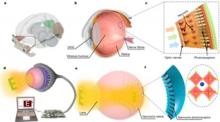
The robots come ( episode 1 )
2. Juli 2020New bionic eye could restore the vision of blind people
Berlin, June 2020
A group of researchers from the United States and Hong Kong (China) has presented a bionic eye prototype that successfully replicates the dome-shaped retina of the human eye while retaining most, if not all, of its desirable characteristics.
The „electrochemical eye“ (or EC-EYE) consists of a highly dense „nanowire“ array that mimics the photoreceptor cells of the human visual organ and is capable of capturing and transmitting images in real time. At present, the bionic device with its 100 pixels can only generate a low resolution image. However, the research group is confident that as the technology develops, the device will eventually be far superior to the natural patterns on which it is based.
According to the engineer and co-author Zhiyong Fan from the Hong Kong University of Science and Technology, the process of making the EC-EYE usable for real human applications could take up to 5 years, but the device could be used in robotics much earlier and without much adaptation.
Artificial intelligence could improve robot-assisted exoskeletons and prostheses for safer walking
Berlin, June 2020
There is probably no terrain – with or without obstacles – that we humans cannot master. Reproducing this ability in robotic prosthetics is a huge challenge for researchers.
Now, scientists at North Carolina State University have integrated robust Ki algorithms into robotic software to help people walk more safely and naturally on different types of terrain.
It is not that difficult to create robotic prostheses or exoskeletons that make walking on a smooth surface easier. What is difficult is making these devices that work well on all types of terrain. This is because walking surfaces that we encounter in our daily lives are usually unpredictable.
In this study, the scientists focused on six different types of terrain: Tile, brick, concrete, grass, „up“ and „down“. They created AI-based software that predicts the type of terrain that users will step on. Based on these predictions, some settings of the prosthesis can be adjusted to make it perfectly suited to the situation.
Interestingly, this software can be integrated into most robotic devices for the lower limbs – both exoskeletons and prostheses. Only one additional piece of hardware is required – a camera. The AI uses visual cues to predict what type of surface the person will step on next.
Before this system could be used, it had to be programmed and trained. In the initial phase, scientists mounted cameras on physically healthy people who then walked through a variety of indoor and outdoor environments. This allowed the system to learn about the different surfaces people walk on and what to expect when they encounter a particular terrain. Although all people are different and walk in different ways, the scientists found that the data collected could be easily transferred from one population to another.
Now the team is working to make the system more efficient, and they want to integrate it into robotic prosthetics.
SlothBot – the highly efficient conservation robot
Berlin, June 2020
The model of SlothBot is the sloth. Its creators are robotic engineers at the Georgia Institute of Technology. First of all, he should learn to take advantage of the low-energy lifestyle of real sloths. Then it gets serious: SlotBot is to watch the battle to save some of the world’s most endangered species. There is probably no better place for this than the Atlanta Botanical Gardens.
SlothBot is powered by solar panels and uses an innovative energy management technology. It moves along a cable stretched between two large trees while monitoring temperature, weather, carbon dioxide levels and other information in the garden’s 30-hectare forest in downtown Atlanta.
„SlothBot uses slowness as a design principle,“ explains Magnus Egerstedt, Professor and Steve W. Chaddick School Chair at the Georgia Tech School of Electrical and Computer Engineering. „This is not the way robots are typically designed today, but because they are slow and hyper-energy efficient, SlothBot will allow us to linger in the environment and observe things that we can only see when we are continuously present for months or even years“.
The robot is programmed to move only when needed and locate sunlight when its batteries need recharging. At the Atlanta Botanical Garden, the SlothBot will operate on a single 100-foot cable, but for larger environmental applications it will be able to switch from cable to cable to cover a larger area.
„The most exciting goal we will demonstrate with SlothBot is to combine robotics and technology with conservation,“ said Emily Coffey, vice president of conservation and research at the Botanic Garden. „We are doing research to protect endangered plants and ecosystems around the world, and SlothBot will help us find new and exciting ways to advance our research and conservation goals. Then she adds: „SlothBot could do part of our research remotely and help us understand what happens to pollinators, plant-animal interactions and other phenomena that are otherwise difficult to observe. Given the rapid loss of biodiversity and the fact that more than a quarter of the world’s plants are potentially threatened with extinction, SlothBot offers another opportunity to work towards the conservation of these species, she says with some pride.


